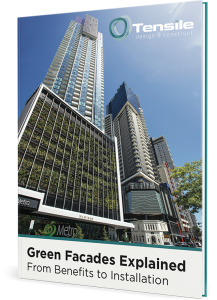Green walls and facades are becoming increasingly popular additions to the exterior of urban buildings. But have you considered creating an interior green facade or wall in your next project?
Interior green facades and walls can be retrofitted to an existing building or incorporated into a new design. They provide numerous measurable benefits, including improved indoor air quality and a more comfortable and attractive atmosphere for living and working.
The benefits of interior green facades
Extensive studies both in Australia and overseas show how indoor greening can act as an air filtering system by removing pollutants such as volatile organic compounds (VOCs).
Indoor greening can also contribute to tackling what is known as sick building syndrome – where low quality indoor air leads to a range of symptoms from headaches, sore throats and skin irritation to respiratory illnesses like asthma.
The Junglefy Breathing Wall in Melbourne is one project that demonstrates the importance of internal green infrastructure.
The wall comprises a series of plant modules in a growing medium, ventilated by an electric fan system that creates the ‘breathing’ effect. Specialised artificial lighting also promotes plant growth and photosynthesis.
Measurable benefits of the wall include CO2 reduction, VOC removal, noise reduction, less need for HVAC use and improved energy efficiency.
The specific needs of interior facades
Interior green facades do however have some differing requirements to their external counterparts.
For example, a lack of natural light might mean that suitable artificial lighting is necessary. In this case, the level of light required by different plant species will need to be considered.
Waterproofing also needs to be addressed. This needs to comply with the building standards used for other indoor wet areas, such as bathrooms and laundries.
Plant nutrition and irrigation requirements may differ from that of an external façade as well.
A lower level of evaporation in an indoor system for example would likely reduce the level of irrigation required.
Tackling indoor pollution one green facade at a time
The World Health Organisation claims that air pollution is a major health risk worldwide.
In light of that and the fact that most of us in urban environments are now spending more than 90% of our time indoors, interior green facades and walls could provide a viable solution to improving the health of our buildings.
If you are considering an interior green facade for your building, contact us to see how we can assist in the design and installation.
Image source: Junglefy





































